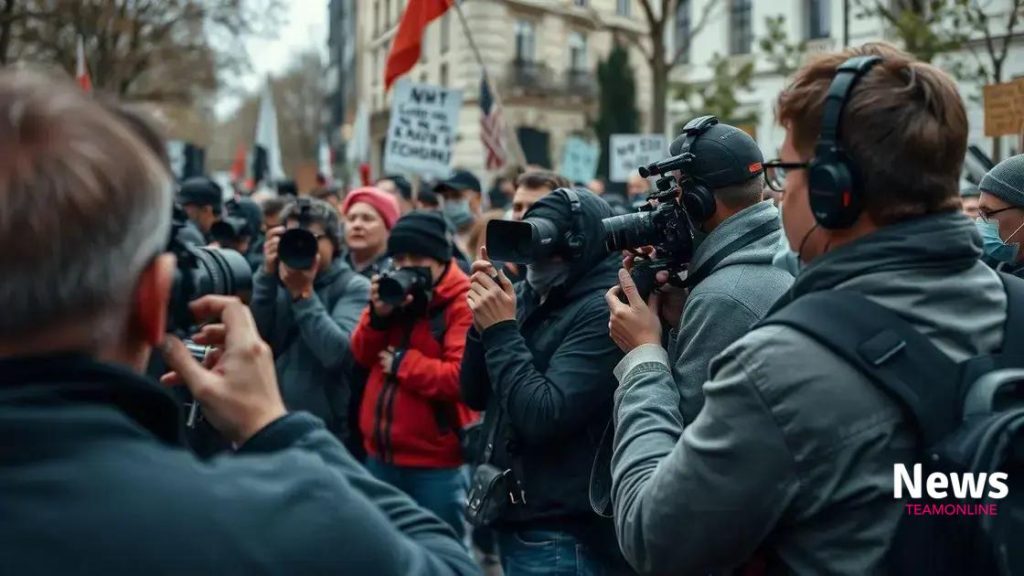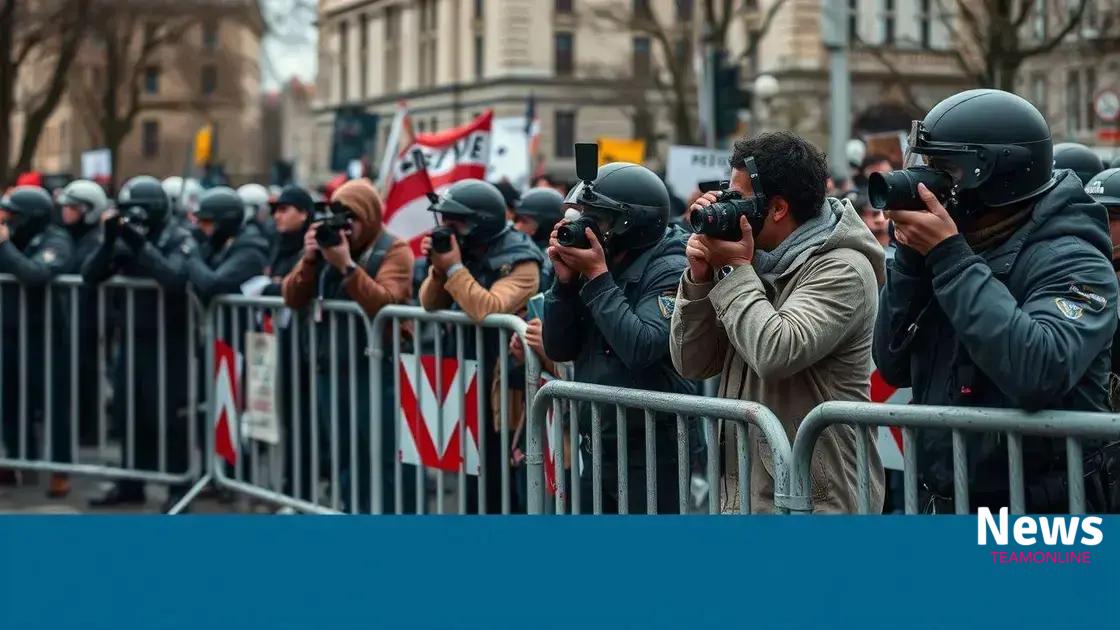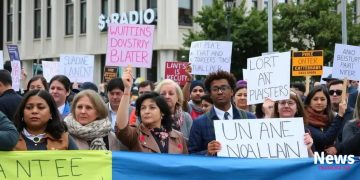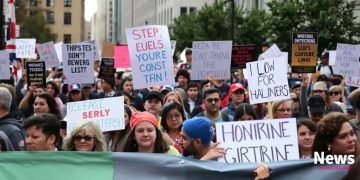Journalist access rights during public demonstrations

Journalist access rights during public demonstrations are shaped by public perception, where trust can enhance media coverage while negative views can restrict journalists, impacting their ability to report effectively on significant events.
Journalist access rights during public demonstrations play a vital role in ensuring the media can report freely on significant events. Have you ever wondered how these rights shape the public narrative during protests?
Understanding the legal framework for journalist access
Understanding the legal framework for journalist access is essential for media professionals to navigate their rights during public demonstrations. Journalists face various challenges aiming to report fairly while ensuring their safety and the public’s right to know.
Key Legal Principles
The core legal principles that support journalist access often derive from constitutional rights and international laws. These principles safeguard journalists enabling them to cover important events without undue interference.
- Freedom of Speech: Many countries guarantee freedom of speech, which extends to the media.
- Public Interest: Journalists have the right to inform the public about significant issues.
- Access to Information: Many laws, like the Freedom of Information Act, ensure journalists can access necessary documents.
Furthermore, laws may vary by country, creating unique challenges for journalists working abroad. Understanding local laws is critical for journalists covering protests around the world.
Case Studies: Impact of Legal Framework
Historically, the legal framework has been tested in court cases that address journalist access. In several instances, rulings have clarified the rights of journalists during public protests. These cases highlight the delicate balance between public safety and media freedom.
For example, during recent protests, courts have reinforced the notion that journalists should have access to public areas to report effectively. However, challenges persist, with law enforcement sometimes restricting access under the guise of safety. This creates a vital discussion on the importance of transparency and accountability in law enforcement actions.
Every journalist should familiarize themselves with the legal protections and limitations relevant to their work. This knowledge not only aids in ensuring journalist access but also empowers them to advocate for their rights.
As the landscape of media continues to evolve, understanding and advocating for these legal frameworks remains crucial. In a world where journalist access can make a pivotal difference, every member of the media must stay informed.
Historical cases of journalist rights during protests
Historical cases of journalist rights during protests have shaped the landscape of media freedom significantly. These landmark events illustrate how the legal framework evolves in response to the changing needs of society.
Significant Legal Battles
Throughout history, various legal battles have highlighted the crucial role journalists play during protests. These cases often reflect a tension between law enforcement and the media, raising important questions about freedom of the press.
- The Pentagon Papers: This case underscored the right of the press to publish sensitive government information, paving the way for greater freedom.
- Occupy Wall Street: During these protests, journalists faced restrictions but effectively argued their right to report on public events.
- Black Lives Matter Protests: Coverage during these protests highlighted the role of journalists in documenting police actions.
Each of these cases emphasizes the need for journalists to have access to public areas, enabling them to report accurately on events that shape our society.
Impact on Legislation
The implications of these historical cases extend beyond the courtroom. They have influenced legislation aimed at protecting journalist access. Many states have enacted laws that guarantee the rights of journalists during public demonstrations.
Understanding these cases helps current journalists navigate their rights effectively. Knowledge of past struggles informs how they advocate for their rights today. As protests continue worldwide, the historical context remains vital for protecting journalist rights.
Moreover, as society evolves, the definition of press freedom adapts too. Journalists must remain vigilant, ensuring that their rights are upheld in the face of new challenges. Each protest not only represents a demand for change but also an opportunity to reinforce the importance of press freedom in a democracy.
The impact of restrictions on media coverage

The impact of restrictions on media coverage during public demonstrations can significantly alter the way events are perceived by the public. When journalists are limited in their ability to report, important stories may go untold.
Consequences of Limited Access
Restrictions often lead to a skewed representation of events. This can create gaps in the public’s understanding of critical issues. Some possible consequences include:
- Loss of Transparency: When journalists cannot report freely, the actions of authorities during protests may remain hidden.
- Public Misinformation: Limited coverage can result in misinformation spreading, as only certain narratives may be amplified.
- Impact on Accountability: Without media oversight, it becomes harder to hold authorities accountable for their actions.
Moreover, when restrictions occur, journalists may feel pressured to self-censor, affecting the integrity of their reporting. They may avoid critical angles that could lead to conflict with authorities.
Changes in Journalism Practice
In response to these challenges, journalists and news organizations adapt their practices. Many use digital platforms to bypass traditional media restrictions. Social media allows direct engagement with the public, helping to fill the information void.
Additionally, collaboration among journalists can become crucial. When individual reporters face restrictions, working together can help ensure that important stories are still covered. Sharing resources and safety information can enhance their ability to report effectively.
Ultimately, the impact of restrictions on media coverage underscores the essential role journalists play in democracy. Their ability to inform the public directly affects the quality of information that reaches society. The struggle for press freedom continues as journalists navigate increasingly complex environments.
Best practices for journalists covering demonstrations
Best practices for journalists covering demonstrations are crucial to ensure accurate reporting and maintain safety. Navigating the complexities of protests requires preparation and awareness.
Preparation and Research
Before attending a demonstration, journalists should conduct thorough research. Knowing the background of the protest can shape the angle of their reporting. Key points to consider include:
- Understanding the cause: Being informed about the issues at stake will help portray the event accurately.
- Identifying key players: Knowing who the speakers and organizers are can provide insight into the protest’s significance.
- Being aware of potential risks: Understanding local laws and the usual police response can help journalists stay safe during coverage.
Preparation also involves ensuring equipment is ready. Journalists should check their cameras, recording devices, and safety gear before heading out.
On the Ground Reporting
When covering a demonstration, journalists need to prioritize their safety while capturing the story. Keeping a low profile and staying aware of the surroundings is essential. They should also maintain clear communication with colleagues.
Using social media can facilitate real-time updates. Live-tweeting or streaming can bring immediate attention to significant incidents. However, accuracy must remain a priority over speed.
During the event, journalists should interview participants and gather diverse perspectives. Hearing different voices provides a fuller picture of the demonstration, enriching the story. Recording audio and taking notes can help capture essential quotes and observations.
Furthermore, establishing trust with sources can lead to more insightful information. Journalists should approach conversations warmly and respectfully.
Maintaining ethics in reporting is paramount. Journalists must be factual and avoid promoting any bias. Respecting privacy and considering the potential ramifications of their coverage also contribute to responsible journalism.
Best practices for journalists covering demonstrations emphasize the importance of preparation, ethics, and accuracy. As the landscape of journalism evolves, these principles help ensure that the voices of the people are heard.
How public perception influences journalist access
Public perception plays a significant role in shaping journalist access during protests and demonstrations. When the public views journalism as a vital tool for accountability, it can enhance media access to events.
The Role of Trust
Trust in the media greatly influences how journalists are treated during protests. If the public believes in the integrity and fairness of the press, they are more likely to support journalistic efforts. Some ways public trust can impact access include:
- Support from Protesters: When journalists are trusted, protesters may invite them to cover their events, leading to more comprehensive storytelling.
- Improved Relations with Authorities: Positive public perception of media can encourage law enforcement to respect journalists’ rights, allowing greater access during events.
- Accountability for Actions: If the public sees journalists as important watchdogs, there may be less tolerance for restrictive measures against them.
However, when public perception is low, journalists may face significant obstacles. For instance, if the media is viewed as biased, protesters may refuse to communicate with them. This mistrust can result in lost stories and important perspectives that might otherwise be heard.
Influence of Social Media
Social media also shapes public perceptions of journalists. Viral posts can sway public opinion quickly, affecting how journalists are perceived in real time. Positive tweets or comments can bolster support for journalists, while negative ones can lead to hostility.
Moreover, protests organized via social media can create spaces for journalists to engage with participants. When public opinion is shared widely, it can either enhance or limit journalists’ access. This highlights the power of collective opinions in shaping narratives.
Maintaining a positive image is crucial for journalists seeking access during protests. They need to showcase their commitment to ethical reporting and represent diverse voices. By engaging with communities and understanding their concerns, the media can build credibility.
Ultimately, public perception directly influences journalist access. A strong, positive relationship between the media and the public can empower journalists to do their jobs effectively, ensuring that essential truths about society are reported.
In conclusion, understanding the dynamics of journalist access during public demonstrations is vital. Public perception greatly influences how journalists operate in these settings. When trust exists between the media and the public, journalists can report more freely and effectively. However, negative perceptions can restrict their access and limit important narratives. By fostering positive relationships and maintaining ethical standards, journalists can enhance their ability to cover significant events. Ultimately, a collaborative approach ensures that diverse voices are heard, and essential truths are brought to light.
FAQ – Journalist Access Rights During Public Demonstrations
Why is public perception important for journalist access?
Public perception impacts how journalists are treated during protests; higher trust leads to better access and coverage.
What role does social media play in journalism during protests?
Social media influences public opinion quickly and can enhance or limit journalists’ access to information at protests.
How can journalists maintain ethical standards while covering demonstrations?
By staying factual, respecting privacy, and representing diverse voices, journalists can build credibility and public support.
What best practices should journalists follow when covering protests?
Preparation, clear communication, and engaging with communities are key practices that can enhance reporting during protests.





